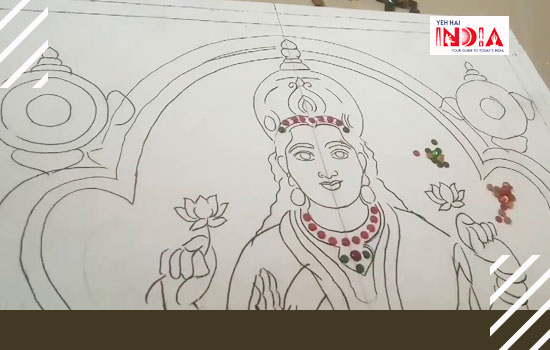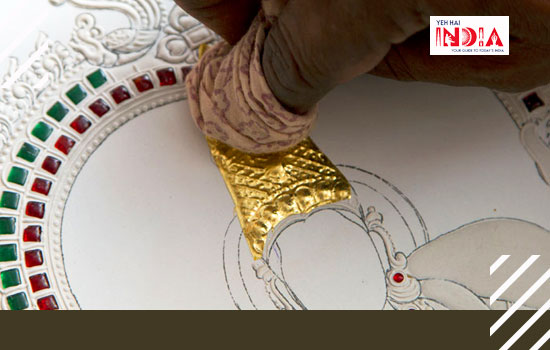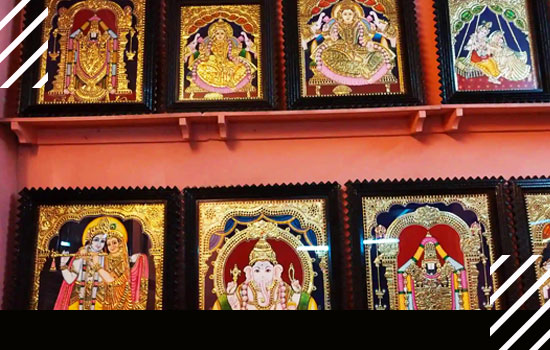Indian culture has many magnificent art forms that enhance the richness of our country.
The traditional art of Tanjore Paintings is one of the famous art forms to survive centuries.
Every state of India has various splendid art forms of their own that have over time elevated the beauty of Indian culture and heritage.
The Thanjavur or Tanjore painting is named after its place of origin which is Tanjore; a town located in the state of Tamil Nadu.
The state is home to some world-famous sanctums, murals and sculptures on the walls of temples.
Apart from this famed cultural heritage, the Tanjore paintings have stood out ever since they have originated.
The Tanjore painting is popularly known as Palagai Padam; referring to the pictures made on the wood as most of these paintings are inscribed on solid wooden boards.
This ancient art form has a divine approach as almost all figurines in the paintings are of gods and goddesses, embellished by stones and vibrant colours.
The creation of Tanjore Paintings is a typical magnum opus requiring perseverance, perfection, and a passion for artistic intricacy.
Recommended Story – Tanjore Paintings : Classical South Indian Painting
The Process of Creating the Masterpiece

The making of Tanjore involves several steps.
The process starts from creating the canvas and ends after meticulously decking it with various beautifying add-ons.
Getting the canvas ready is considered to be a challenging job.
However, once this canvas is prepared, the process of layering it begins.
A number of creative materials are required to make the masterpiece of Tanjore painting.
Materials Required
- A wooden board of preferred size and thickness
- White cotton cloth (larger than the board)
- Fevicol
- Chalk powder
- Any Indigenous gum like the Arabic Gum
- Sandpaper
- Flat and Rounded brushes,
- Gold foil
- Poster colors
- Black pen
- Yellow Carbon paper
- Pencil
- Cutter
- Ruler
- Decorative stones as per preference
- Reference art that you wish to trace
Creating the Canvas

The first thing in the process of making a Tanjore painting is to create the base of plywood with the cotton cloth stuck on it.
Step 1- Soften the edges of plywood with sandpaper to make the next steps easy.
Step 2- Create a paste of Fevicol and water in the ratio of 4:1. Filter this paste to make sure there’s no unwanted waste in the mixture.
Step 3- Immerse the cotton cloth in the prepared paste. After a few minutes, take the wet cloth out and rinse it properly so that the extra liquid gets drained.
Step 4- Now spread the cotton cloth proportionally on the plywood and wipe it gently from the centre to the edge.
Fold the extra cloth left on the edges on the other side and stick it with the use of Fevicol.
Make sure you stretch and pull the extra cloth properly to avoid wrinkles and create a smooth surface. Leave the canvas to dry for a couple of hours.
The next steps involve the process of layering the canvas with another created paste after which, the board will be ready to draw the painting.
Step 5- To create the second paste, we need chalk powder, water and Fevicol in the ratio of 2:1:1. Mix the paste nicely to get the smooth mixture.
Step 6- Apply the paste horizontally on the canvas with a wide brush and leave it to dry. After 10-15 minutes, apply the paste vertically and let it dry.
Repeat the process to apply multiple coats and leave the canvas to dry for a day.
This is one of the most important steps as coating the board helps to prevent the painting from damage caused by heat and moisture.
Step 7- Fold the sandpaper as a long stripe and rub it over the canvas in a circular motion. Use a dry brush the clean the canvas. This step helps in getting a smooth and even surface.
The canvas is now ready for Tanjore painting.
Tracing the Design

The next thing to do in the process of creating Tanjore is to choose the design you want to make in the painting.
Keep the carbon paper on the canvas and trace the design with a pen or pencil.
The purpose of this step is to make an outline of the design to fill it with add-ons in the following steps. Therefore, there’s no need to go into intricate details.
Also, it’s important to have patience and draw the design with concentration to avoid any possible mistakes or confusion.
Recommended Story – Thangka Painting from Ladakh – The meditational Buddhist Artform
Embossing Sculpture to Attain a 3D Effect
This step in the process includes the creation of embossing gum to create the sculpture on the canvas.
The embossed sculpture is what provides the painting with a three-dimensional or raised effect, making it a state of the art.
Step 1- Mix the Arabic gum, chalk powder and Fevicol in the ratio of 1:2:1 to create the embossing gum.
Apply a smooth layer of this gum with a flat or round brush in the decorative areas. Leave the canvas to attain the effect for more than a day.
The process of embossment can be repeated according to the preferred raised effect.
Step 2- Mark the places you want to add stones or other decorative items, with a pen or pencil.
Step 3- Mix a few drops of water with the Fevicol and use it to stick the stones, pearls, beads, etc. Let the canvas dry for another day.
Step 4- Apply another layer of embossing gum over the decorative materials. This will a shining effect and smooth texture to the glittering area of your Tanjore painting.
Step 5- Use wet cotton to gently rub the embossed area in a circular motion. Make sure you maintain the neatness in the area that is to be painted in the following steps.
The Layer of Gold

Gold foil is the most important element of the painting which makes Tanjore art different from all other art forms.
This step involves the addition of that Gold layer to the painting.
Step 1- Mark the design on the embossed area with a ball pen to avoid mistakes.
Step 2- Create a mixture of Arabic gum, Chalk powder and Fevicol in the ratio of 2:2:1 and fill it in a cone.
Step 3- Carefully fill this mixture with the cone on the areas that are to be layered with Gold foil.
Make sure you fill the areas in detailed traditional designs to give your painting the traditional look.
For example, if the painting has borders as that of temple pillars (which most Tanjore paintings have), intricately fill those parts with a little traditional design.
Let this layer dry for a while.
Step 4- Place the Gold foil sheet over the layered area and mark the edge impressions with your thumb to cut the foil according to the required shape.
Step 5- Cut the required shapes of Gold foil leaving an extra 3-4 mm than the required sizes.
Step 6- Apply the mix of Fevicol & a few drops of water in the back of the Gold foil and place it over the embossed area.
Step 7- Use the pointed back of a brush to press down the foil in order to reveal the details.
Remove the foil pasted over stones by gently applying a wet brush over the decorative materials and cleaning the corners with a safety pin or cotton buds.
Your Tanjore painting is finally ready to be painted!
The Final Step of Painting

Carefully paint the figures and background with appropriate and preferred shades of poster colours.
The background is mostly painted with dark hues of red, green and blue while the insides are filled with light shades.
Once the painting is done, leave it to dry.
Lastly, get your Tanjore Painting framed and here you go, your majestic Tanjore Art is finally ready!
Share your results with us in the comment box!
Also Read – Rajput Painting










